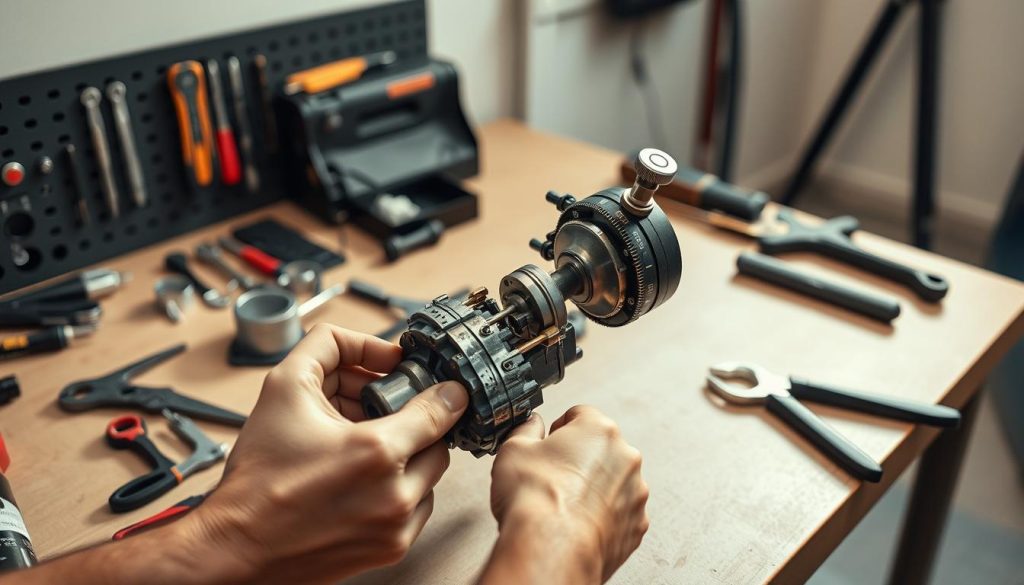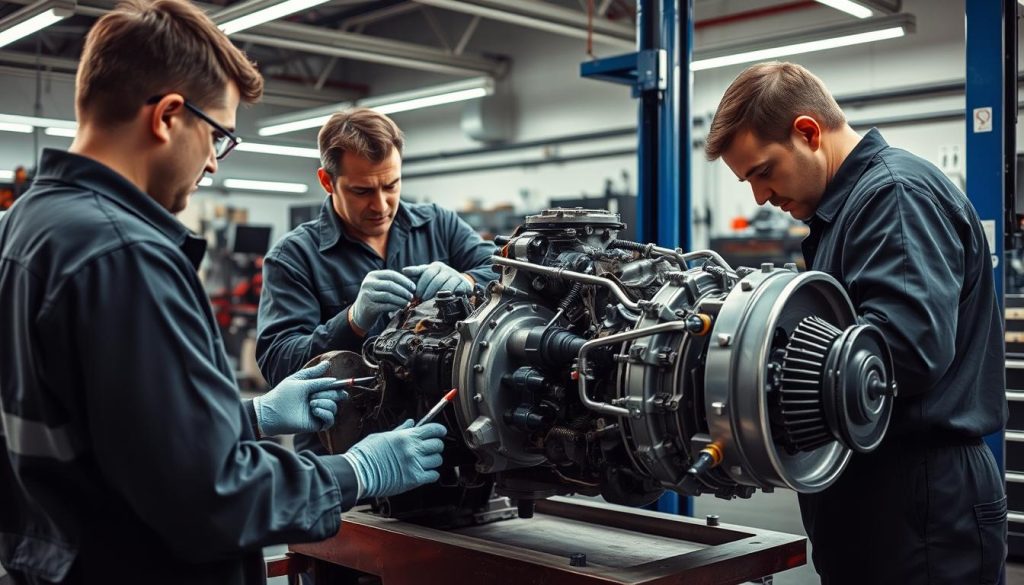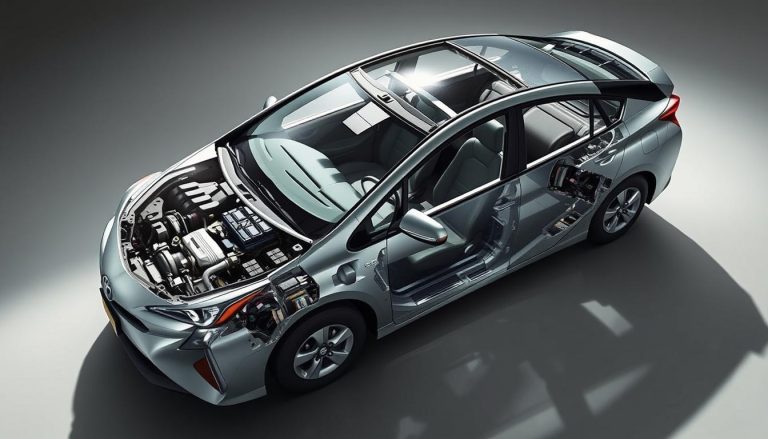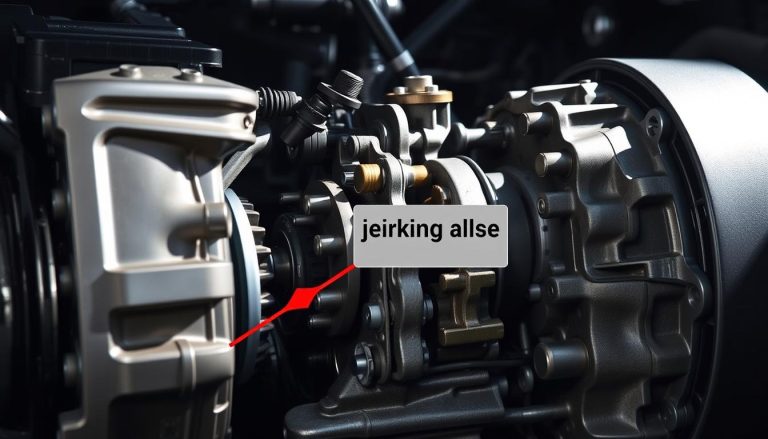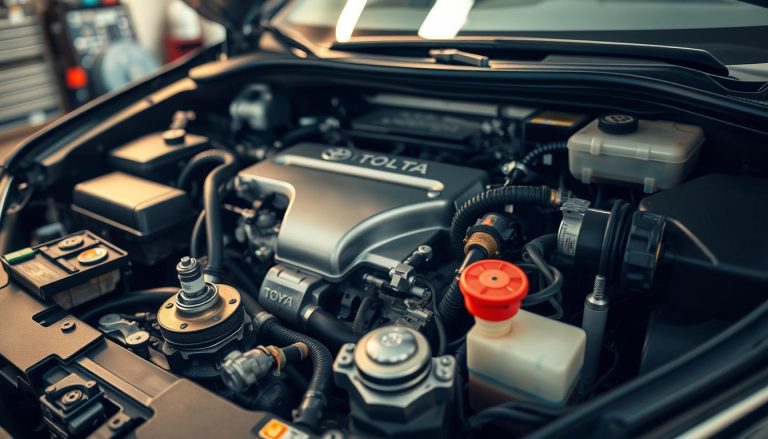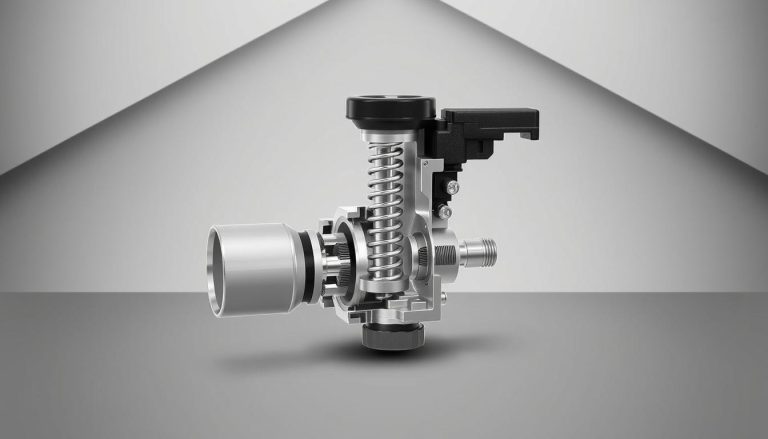Toyota Gear Shift Issues & Troubleshooting
The transmission is key to your Toyota’s performance. It moves power from the engine to the wheels. Spotting problems early can save you from expensive fixes. This guide will show you how to fix common gear shift issues, keeping your Toyota running smoothly.
Recognizing Common Symptoms in Toyota Transmission
Spotting common gear shift problems in Toyota vehicles early can prevent big repairs later. Knowing the signs of Toyota automatic transmission issues helps keep your car running well.
Delayed Gear Engagement
A delay when shifting gears is a first sign of Toyota automatic transmission issues. You might notice a lag in acceleration after moving the gear lever.
Slipping Gears
If your Toyota slips out of gear or shifts without you touching it, it’s a big problem. This can make driving unsafe and needs quick action.
Unusual Noises
Strange sounds like whining, clunking, or grinding when shifting gears are bad signs. These noises usually mean there’s damage or wear inside the transmission.
Leaking Fluid
Fluid leaks under your Toyota, looking reddish or brownish, mean trouble. Keeping the fluid levels right is key for smooth shifting.
Burning Smell
A burning smell from your Toyota means the transmission fluid is too hot. This smell means the fluid needs to be changed fast.
Dashboard Warning Light
Dashboard warning lights, like the “Check Engine” light, warn of Toyota automatic transmission issues. These lights tell you there’s a problem that needs a pro to fix.
Common Causes of Toyota Transmission Problems
Knowing why your Toyota’s gear shift might not work is key. Many things can cause issues, like fluid levels, clutch parts, sensors, wear, and software bugs. Let’s look at each one.
Low or Dirty Transmission Fluid
Fluid is essential for smooth shifting. If it’s low or dirty, shifting can be tough. Always check and change the fluid to avoid problems.
Worn Clutch Components
The clutch is vital in manual transmissions. It can wear out, making shifting hard or even stopping the car. Check it often and replace parts as needed.
Faulty Sensors
Sensors help the transmission change gears well. If they fail, shifting can be off. Make sure sensors work right for smooth shifting.
Mechanical Wear
Use over time wears down the transmission. This can cause noises, hard shifting, and poor performance. Regular care can help parts last longer.
Software Issues
Modern Toyotas use software for transmission control. Bugs in this software can cause shifting problems. Keep the software up to date to avoid these issues.
| Issue | Cause | Prevention |
|---|---|---|
| Low or Dirty Fluid | Infrequent fluid changes | Regularly check and change fluid |
| Worn Clutch Components | Mechanical wear | Routine inspections |
| Faulty Sensors | Electronic failure | Sensor diagnostics |
| Mechanical Wear | Age and usage | Timely replacements |
| Software Issues | Glitches in TCM | Update software regularly |
Toyota Gear Shift Problems: Typical Issues
Toyota cars are known for being reliable. But, even the most dependable vehicles can have gear shift problems. A common issue is when the gear shift gets stuck. This can happen for many reasons, like misaligned gears or wear and tear inside the transmission.
If your Toyota’s gear shift gets stuck, knowing why is key to saving money on repairs. Issues can include a faulty shift interlock system or problems with the transmission control module. Spotting these problems early can help keep repair costs down.
Another issue is when the gear shift won’t move. This might be due to electrical problems, mechanical issues, or even a blown fuse. Catching these problems early can prevent bigger damage to the transmission. This helps keep repair costs in check.
Here’s a list of common Toyota gear shift problems and what might cause them:
| Problem | Typical Causes |
|---|---|
| Gear Shift Stuck | Shift interlock system failure, gear misalignment, internal transmission wear |
| Unresponsive Gear Shift | Electronic faults, mechanical failures, blown fuse |
DIY Solutions for Minor Transmission Issues
For minor Toyota automatic transmission issues, you can take a few steps before a pro helps. These actions can keep your car running well and might even save you cash.
Check Transmission Fluid Levels
First, make sure the transmission fluid is at the right level. Low fluid can cause gear problems. Use the dipstick when your Toyota is running and on a flat surface.
Inspect the Fluid Condition
Then, check the fluid’s condition. If it’s dark, gritty, or smells burnt, it’s time for a change. Clean fluid is key for your Toyota’s smooth running.
Reset the Transmission
At times, a simple reset can fix Toyota automatic transmission issues. Try disconnecting the battery for 30 minutes. Then, reconnect and test to see if the problem is gone.
Ensure Proper Driving Habits
Your driving style affects your Toyota’s transmission. Avoid sudden starts and stops. Gentle driving helps your car last longer.
When to Seek Professional Help for Your Toyota
If you’re having trouble with your car’s transmission, even after trying to fix it yourself, it’s time to get help. This is very important. It’s because finding the real problem often needs special tools and skills.
Certified Toyota mechanics can do a deep check to find the real issue. They use advanced tools that can spot problems that you can’t see. This is because they have the right training and tools.
Getting a professional to fix your car’s gearbox means they check everything carefully. This lowers the chance of the same problem happening again. Also, getting a pro helps you know the real cost of fixing your Toyota. This way, you avoid spending more money on bad fixes later.
Here is a detailed comparison of DIY repairs versus professional services:
| Aspect | DIY Repairs | Professional Services |
|---|---|---|
| Diagnostic Accuracy | Limited | High |
| Tools & Equipment | Basic | Advanced |
| Repair Quality | Varies | Consistent |
| Reliability | Uncertain | Guaranteed |
| Long-term Costs | Potentially Higher | Potentially Lower |
When DIY fixes don’t work, getting a professional is a wise choice. It makes sure your car is fixed right. And it keeps your Toyota running well for a long time.
Preventing Transmission Problems in Toyota Vehicles
Keeping your Toyota’s transmission in top shape requires regular care. By following these steps, you can avoid serious transmission problems. Here’s how to maintain your Toyota’s gear shift and transmission health.
Regular Fluid Changes
Changing the transmission fluid regularly is key. This fluid keeps the transmission parts lubricated and cool. Over time, it can get dirty and lose its effectiveness. Check your owner’s manual for when to change the fluid.
Routine Inspections
Regular inspections can catch small problems before they get big. A skilled technician will look for wear or malfunctions in the transmission. These checks are part of routine service, saving you from expensive repairs later.
Don’t Ignore Warning Signs
Ignoring early signs of trouble can harm your transmission. Look out for unusual noises, slow gear changes, or fluid leaks. Fixing these issues quickly can prevent major damage and keep your transmission healthy.
Use Genuine Toyota Parts
Always choose genuine Toyota parts for repairs and replacements. They’re made to fit and last, ensuring your transmission works right. Using other parts might cause more problems and not be as reliable.
Difficulty Shifting Gears in Toyota Vehicles
Having trouble shifting gears in Toyota vehicles can be really frustrating. It might mean there’s a problem with the transmission. Issues like damaged clutches, gear linkages, low transmission fluid, or a faulty transmission control module could be the cause. Fixing these problems quickly can stop more damage and keep your vehicle running smoothly.
One big issue is when clutch parts wear out. If clutches are damaged, it’s hard to shift gears smoothly. Also, if gear linkages are not working right, it can cause shifting problems. These linkages help move the driver’s shift lever to the transmission.
Low transmission fluid is another big problem. If there’s not enough fluid or it’s dirty, it can cause friction and heat. This makes shifting gears harder. It’s important to check and maintain fluid levels regularly. A bad transmission control module can also cause shifting issues. This part controls how the gears shift in modern cars.
Fixing gear shift problems in Toyota vehicles quickly is key to keeping your car running well. If you’re having trouble shifting, it’s best to get a professional mechanic to check it out. They can find and fix the problem, making sure you can drive safely and reliably.
Unusual Noises Coming from the Gearbox
Unusual noises when shifting gears in your Toyota can be a worry. Sounds like whining, grinding, or clunking might mean there’s a problem inside. Fixing these noises quickly can stop bigger problems and keep your car running well. Let’s look at the common sounds and what they might mean.
Whining Sounds
A whining sound when shifting gears often means the transmission fluid is low or dirty. This can cause the gearbox to not get enough lubrication. It could also be due to worn-out bearings in the transmission. If you hear this, it’s important to check and maybe replace the transmission fluid to avoid more damage.
Grinding Sounds
Grinding sounds during gear changes are a sign of serious damage. This usually means the gears and synchronizers inside the gearbox are worn or damaged. If you keep hearing this, it’s best to have a professional check and fix it to keep your transmission working right.
Clunking Sounds
Clunking noises while shifting gears are alarming and usually mean something is seriously wrong. These sounds can come from damaged gears, broken transmission mounts, or worn-out universal joints. It’s important to act fast to find and fix the problem, so your Toyota keeps running smoothly.
Slipping Gears During Acceleration or Deceleration
Slipping gears during acceleration or deceleration is common in vehicles with automatic transmissions. This is often seen in Toyota models. The engine might rev higher than usual, but the speed doesn’t increase. Catching these problems early can stop more damage to your car’s transmission.
- Worn-out Clutches: Clutches can wear out over time, causing poor engagement and slipping.
- Low Fluid Levels: Enough transmission fluid is key for smooth shifts. Low levels can cause slipping and overheating, leading to Toyota automatic transmission issues.
- Transmission Solenoid Problems: Faulty solenoids can result in wrong gear changes and shift problems.
Regular checks and quick repairs are key to avoid these issues. If you see the engine revving too high during gear changes, get a mechanic’s help right away. Fixing these problems early can prevent expensive repairs and make driving smoother.
Warning Lights Indicating Gearbox Problems
When Toyota dashboard warning lights come on, it’s important to take notice. These lights often mean there’s a problem like low transmission fluid or overheating. If you ignore these signs, you might face expensive repairs later.
The transmission temperature light is a common warning. It means the gearbox is too hot. This could be because of too little transmission fluid or a cooling system issue. Another warning light, the generic dashboard light, might show a sensor problem or an electrical issue affecting the transmission.
These warning lights are important. They tell you to check for gearbox problems and fix them quickly. By paying attention to these warnings, you can avoid costly repairs and keep your car running well.
Fluid Leaks or Low Transmission Fluid Levels
Spotting and fixing Toyota gearbox leaks is key to avoiding big transmission problems. These leaks show wear and tear in the gearbox. If not fixed quickly, they can cause even more damage. Keeping the fluid level right is also important for the gearbox’s health.
The gearbox needs clean transmission fluid to work well. Leaks can cause issues like rough shifting and overheating. Regular checks for leaks and fluid levels can help avoid these problems.
Keeping Toyota transmission fluid at the right level is easy. Just check it often and add more when needed. Using the right transmission fluid for Toyota cars keeps the gearbox running smoothly for longer.
| Issue | Symptom | Solution |
|---|---|---|
| Toyota Gearbox Leaks | Fluid puddles under the vehicle | Identify the source and replace seals |
| Low Transmission Fluid Levels | Slipping gears, overheating | Top off and use Toyota-recommended fluid |
| Routine Maintenance | Consistent smooth operation | Adhere to scheduled fluid changes |
By fixing Toyota gearbox leaks and keeping the transmission fluid right, you help your car’s transmission last longer. This ensures your car runs smoothly for years to come.
The Cost of Fixing Toyota Gear Shift Issues
Knowing the cost of fixing Toyota gear shift problems is key for car owners. The price can change a lot based on the issue’s type and how bad it is. Small fixes like adjustments or fluid changes might cost less. But bigger repairs can be more expensive.
Keeping up with regular maintenance helps keep repair costs down. Catching problems early, like strange noises or slow gear changes, can stop bigger issues later. Regular checks and quick fixes can save you money and make your car last longer.
It’s smart to get help from experts for quality repairs. Toyota service centers with certified mechanics use the right parts. This might seem pricey at first, but it can save you money in the long run by avoiding more repairs.
| Service Type | Estimated Cost |
|---|---|
| Fluid Replacement | $100 – $200 |
| Gear Linkage Adjustment | $200 – $300 |
| Sensor Replacement | $300 – $500 |
| Complete Transmission Repair | $1,000 – $3,000 |
The Importance of Regular Gearbox Inspections
Keeping your Toyota’s gearbox in top shape is key for its long life and smooth running. Regular checks can spot problems early, avoiding big damage and high repair costs.
During these inspections, mechanics look at the gearbox’s fluid levels, gear condition, and how the transmission works. They find wear and tear or early signs of trouble. If ignored, these can turn into bigger issues.
Also, regular maintenance might include updating the gearbox’s software for better performance. Software problems can slow down the transmission, so updates are important. Mechanics check for leaks and odd noises, signs of trouble that need fixing fast.
Another important part of regular checks is making sure the gearbox fluid is good and at the right level. This fluid keeps the gearbox cool and moving smoothly. It prevents overheating and reduces friction. Clean, well-maintained fluid is essential for the gearbox’s health.
In short, regular gearbox inspections are vital for your Toyota’s performance and to avoid expensive fixes. By focusing on gearbox maintenance and regular checks, you keep your vehicle’s transmission running well.
Professional Services for Toyota Gearbox Repairs
Looking for professional Toyota gearbox repair? A certified Toyota service center is your best bet. They have the latest tools and tech for accurate repairs. The experts there are trusted Toyota transmission specialists ready to tackle tough issues.
These pros do thorough checks and use real Toyota parts. Their skill ensures your car gets top-notch care. This means your transmission lasts longer and your car runs better. Regular check-ups and quick fixes by trusted Toyota transmission specialists keep your Toyota in top shape.
Choosing a professional Toyota gearbox repair service means quality work and peace of mind. Your car is in good hands with certified Toyota experts. If you have gearbox worries, don’t wait to get help from them.
Conclusion
Fixing Toyota gear shift problems quickly is key to keeping your car running well. Knowing the signs like delayed gear changes, slipping, and odd noises helps. This way, small issues don’t turn into big repairs.
This guide helps you tackle transmission troubles. It covers checking fluids and the need for regular checks. Using these DIY tips can save you money and keep your car running smoothly.
But, for serious problems, it’s best to get help from a pro. Regular maintenance, using Toyota parts, and acting fast on warning signs keep your car safe and reliable. These steps not only make driving better but also make your car last longer.
FAQ
What are the common symptoms of transmission issues in Toyota vehicles?
Signs include delayed gear engagement and slipping gears. You might also hear unusual noises like whining or clunking. Leaking transmission fluid, a burning smell, and dashboard warning lights are other indicators.
What causes Toyota gear shift problems?
Problems can stem from low or dirty transmission fluid. Worn clutch components and faulty sensors also play a role. Mechanical wear and software issues in the transmission control module can cause issues too.
How can I recognize early signs of transmission issues in my Toyota?
Look out for unusual noises from the gearbox and slipping gears. Dashboard warning lights are also a sign. Regular checks can help catch problems early.
What should I do if I notice unusual noises coming from my Toyota’s gearbox?
Noises like whining or grinding often mean internal damage. It’s vital to get a professional to inspect the transmission. This can prevent costly repairs.
How can I prevent transmission problems in my Toyota?
Regularly change the transmission fluid and have routine inspections. Address warning signs quickly. Using genuine Toyota parts for maintenance and repairs helps too.
What should I check if my Toyota’s transmission is not working properly?
First, check the transmission fluid levels and condition. If it’s dark or smells burnt, it might need changing. Resetting the transmission control module and driving carefully can also help.
When should I seek professional help for my Toyota’s transmission issues?
If DIY fixes don’t work or problems persist, get professional help. Certified Toyota technicians can do detailed diagnostics and repairs.
How can fluid leaks affect my Toyota’s transmission?
Leaks or low fluid levels can cause overheating and wear. This harms the transmission’s performance and lifespan. Fixing leaks and keeping fluid levels right is key.
What are the repair costs for fixing Toyota gear shift problems?
Costs vary based on the problem’s severity. Early detection and regular maintenance can lower costs. Using certified Toyota service centers ensures quality repairs and saves money.
Why are regular gearbox inspections important for my Toyota?
Regular checks catch issues early, allowing for prevention and avoiding expensive repairs. This keeps your Toyota’s transmission healthy and efficient.


